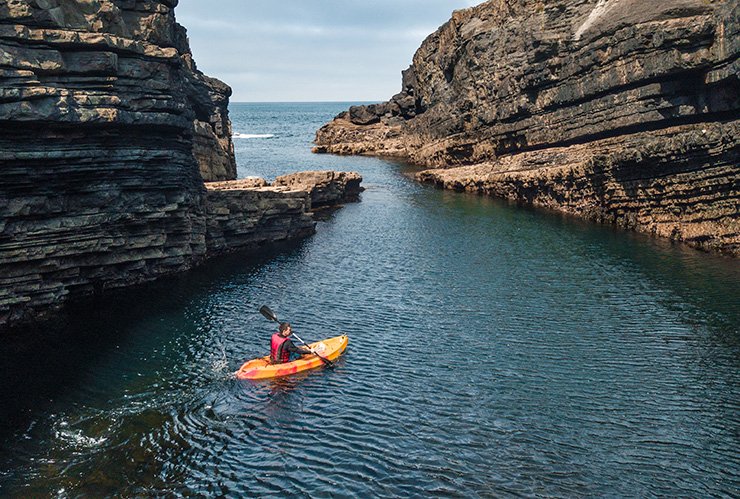Do you need a life jacket to kayak? The answer is yes! A life jacket (sometimes referred to as a PFD or Personal Flotation Device) is both a legal requirement and a life-saving piece of equipment.
This article will explain everything you need to know about life jackets, including the best life jackets for kayaking and why they are legal and necessary for any kayaker.
RELATED: Kayaking Safety Tips You Need to Know
Key Takeaways
- A life jacket is a key safety accessory for kayaking and a legal requirement across the USA.
- Children are required by law to wear a life jacket at all times when kayaking and adults are required to have one on board.
- There are different types of life jackets (I, II, III, or V) that suit different water conditions and activities.
- A life jacket should fit properly, be made of quality materials, and have the necessary extra features.
- There are some common myths about life jackets that can put your safety at risk, such as not needing one if you can swim or if you are near the shore.
Why Do Kayakers Need a Life Jacket?
There are several reasons that someone might need to wear a life jacket. The first and most important is personal safety; life jackets are designed to help keep you floating in cold/warm water even when you’re exhausted.
The second reason is that they are mandatory by law across the USA. While the legislation isn’t the same everywhere, in nearly all cases you have to have at least one life jacket per person in the kayak.
Life jackets are an instrumental piece of gear, not just a flotation aid. Many have pockets or attachments that can be used to store essential equipment.
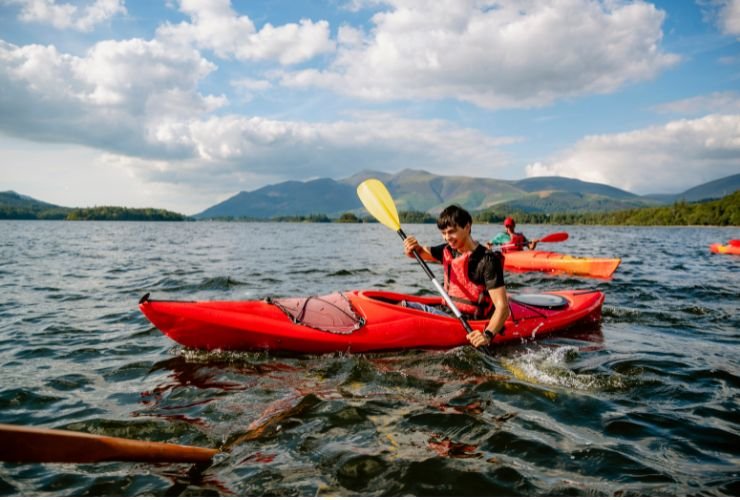
Every State in the US Requires a Lifejacket When Kayaking
While there are similarities among the different states of the US when looking at life jacket requirements, there are also some differences that can be useful to know:
| Name of State | State Requirements |
| Alabama Life Jacket Laws | One life jacket per person. |
| Alaska Life Jacket Laws | One life jacket per person, in an easily accessible location. |
| Arizona Life Jacket Laws | One life jacket per person, in an easily accessible location. |
| Arkansas Life Jacket Laws | One life jacket per person, in an easily accessible location. |
| California Life Jacket Laws | One life jacket per person, in an easily readily accessible location. |
| Colorado Life Jacket Laws | Any vessel less than 16 feet in length must be equipped with one life jacket per person. |
| Connecticut Life Jacket Laws | One life jacket per person – also, if you’re in a manually paddled boat, you have to wear your life jacket at ALL times. |
| Delaware Life Jacket Laws | One life jacket per person, children under 12 must wear a life jacket at all times. |
| Florida Life Jacket Laws | A wearable PFD (aka a life jacket or vest) for each person aboard. |
| Georgia Life Jacket Laws | A life jacket or vest for each person, in an easily accessible location. |
| Hawaii Life Jacket Laws | All vessels must have a USCG approved life jacket per person aboard. |
| Idaho Life Jacket Laws | One life jacket per person aboard. |
| Illinois Life Jacket Laws | One USCG approved life jacket per person. |
| Indiana Life Jacket Laws | One USCG approved life jacket per person. |
| Iowa Life Jacket Laws | One USCG approved life jacket per person. |
| Kansas Life Jacket Laws | One USCG approved life jacket per person. |
| Kentucky Life Jacket Laws | One USCG approved life jacket per person. |
| Louisiana Life Jacket Laws | One USCG approved life jacket per person, if you have an outboard motor: your life jacket MUST be worn at all times. |
| Maine Life Jacket Laws | One USCG approved life jacket per person. |
| Maryland Life Jacket Laws | One USCG approved life jacket per person. |
| Massachusetts Life Jacket Laws | One USCG approved life jacket per person. |
| Michigan Life Jacket Laws | One USCG approved life jacket per person. |
| Minnesota Life Jacket Laws | One USCG approved life jacket per person. |
| Mississippi Life Jacket Laws | One USCG approved life jacket per person. |
| Missouri Life Jacket Laws | One life jacket per person on board. |
| Montana Life Jacket Laws | One wearable PFD per person on board. |
| Nebraska Life Jacket Laws | All motorized and non-motorized vessels must be equipped with one life jacket per person on board. |
| Nevada Life Jacket Laws | One USCG approved life jacket per person. |
| New Hampshire Life Jacket Laws | All vessels must have one life jacket per person on board. |
| New Jersey Life Jacket Laws | One USCG approved PFD per person on board. |
| New Mexico Life Jacket Laws | Anyone in a kayak MUST wear a USCG approved life jacket whenever they are in the vessel. |
| New York Life Jacket Laws | All vessels must have one USCG approved life jacket per person. |
| North Carolina Life Jacket Laws | All vessels must have USCG approved PFD for each person on board. |
| North Dakota Life Jacket Laws | All non-motorized vessels must have one USCG approved life jacket per person. |
| Ohio Life Jacket Laws | All vessels must have one USCG approved life jacket per person on board. |
| Oklahoma Life Jacket Laws | All vessels must have one USCG approved life jacket per person on board. |
| Oregano Life Jacket Laws | All vessels must have a life jacket for each person on board. |
| Pennsylvania Life Jacket Laws | A life jacket must be onboard the vessel at all times of the year, between the dates of November 1st and April 30th you MUST wear a life jacket at all times. |
| Rhode Island Life Jacket Laws | One USCG approved life jacket per person on board. |
| South Carolina Life Jacket Laws | All vessels must have a USCG approved life jacket for anyone on board OR being towed. |
| South Dakota Life Jacket Laws | All kayaks must have a life jacket for each person on board. |
| Tennessee Life Jacket Laws | All kayaks must have one USCG approved life jacket per person on board. |
| Texas Life Jacket Laws | All kayaks must have one USCG approved life jacket per person on board. |
| Utah Life Jacket Laws | All kayaks must have one USCG approved life jacket per person on board. |
| Vermont Life Jacket Laws | All kayaks must have one USCG approved life jacket per person on board. |
| Virginia Life Jacket Laws | All kayaks must have one USCG approved life jacket per person on board. |
| Washington Life Jacket Laws | All kayaks must have one USCG approved life jacket per person on board. |
| West Virginia Life Jacket Laws | All kayaks must have one USCG approved life jacket per person on board. |
| Wisconsin Life Jacket Laws | All kayaks must have one USCG approved life jacket per person on board. |
| Wyoming Life Jacket Laws | All kayaks must have one USCG approved life jacket per person on board |
A lot of these different state legislations are worded differently but say more or less the same thing. However, a few states do require some subtle differences, so be sure to check what the table above says for your specific state.
Another thing is that some of the states above don’t specify “USCG approved” (This just means United States Coast Guard). But that’s because the USCG must approve every life jacket for ANY recreational vessel (including kayaks).
Some states also specify a maximum length (like 26 feet and under) for the life jacket legislation to apply, but there isn’t a kayak that can exceed this in 99 percent of cases.
There are different types of life jackets; type I, II, III, or V, and a good rule of thumb is to choose type I, II, or III. These are accepted in nearly every state (if you’re going to be kayaking across multiple states).
This guide will further delve into more detail about the different types if you’re interested.
The Importance of Safety While Kayaking (Especially for Children)
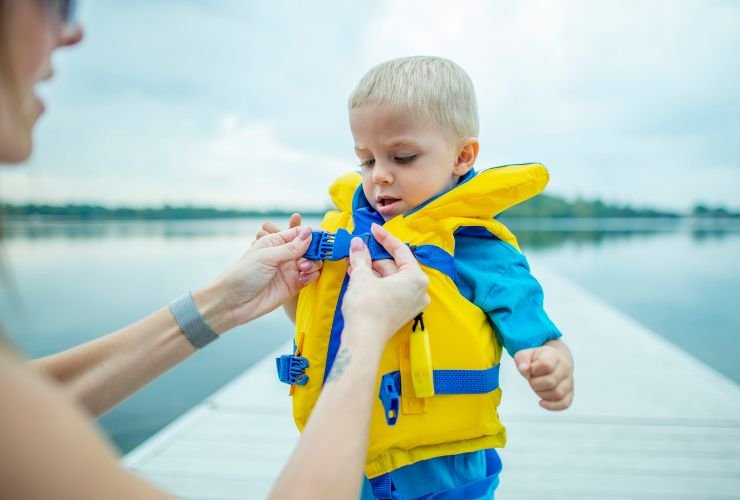
In most states, children 12 and under must wear a life jacket at all times. However, this changes frequently, and you should go to your state’s website to double-check this information.
In some states, it goes as low as 8 and under, but in some, it goes as high as 14 – the PFD minimum age varies across the board, and the information is updated regularly.
To avoid unnecessary complications, your child should wear a life jacket ANY time in a kayak. Some states even specify that a child should wear a life jacket before entering a kayak.
A good general rule of thumb is to put your life jacket on your child before they get in the kayak and keep it on.
Legal Consequences of Not Wearing a Life Jacket
In every state failure to comply with life jacket laws has a punishment.
These punishments range from:
- Fines that range from $100 to $1000 and above.
- Jail time (which can go up for previous offenses).
- A requirement to attend courses on boating safety.
Make no mistake, a life jacket is not optional. Police regularly stop kayakers and inspect that they have all the necessary safety equipment. If life jackets are damaged or in hard-to-reach locations, you can potentially get in trouble for this too.
Life Jackets Give You Added Functionality
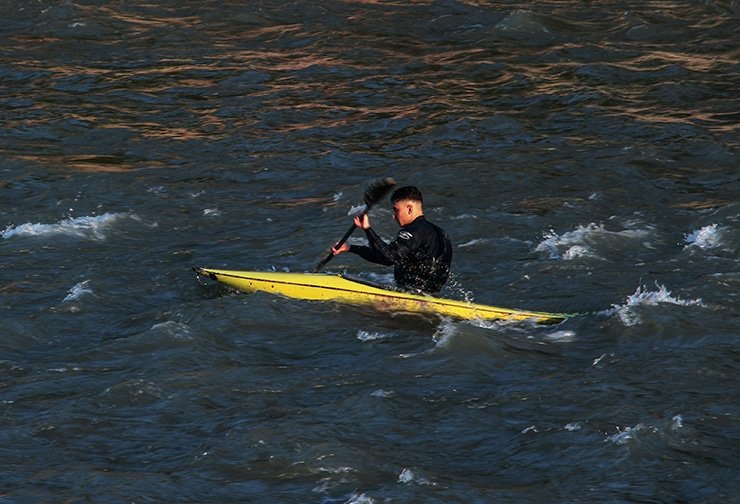
Depending on the type of kayaking you’re engaging in, life jackets can give you some useful added functionality.
There can be pockets where you can put small bottles of water, a flashlight, and snacks, or you can get a waterproof phone case and keep your phone on your person.
There are additional features a life jacket can have, no matter what kind of kayaker you are!
Do Different Waterways Need Different Life Jackets?
While most life jackets are fine for kayaking, some things must be considered.
There are different kinds of life jackets, and these have different amounts of buoyancy, which usually means they handle certain conditions better than others.
The section below will explain these different kinds of life jackets and where they excel.
The Different Types of Life Jackets
The different types of life jackets are type I, II, III, or V the US Coast Guard (USCG) recognizes these different types.
Kayak life jacket laws across the states can be a bit confusing, so if you’ve ever wondered what these different kinds of life jackets do, then they’ll be explained here.
Type I
22 lbs minimum buoyancy)
These are built for maximum protection. They are ideal for offshore kayakers or anyone who intends to kayak in rough waters. They are very effective but bulky and uncomfortable.
They can also be pricey, and few are available for private buyers.
Type II
15.5 lbs minimum buoyancy
These offer less protection than Type I’s but are more readily available and not as bulky. They are great for kayakers on inland waters or closer to the shore.
These are not the best for anyone going far from the shore or anyone who might be heading into very choppy waters.
There are also automatically inflatable type II life jackets available with more buoyancy, but these can be very pricey and are also a bit harder to find.
Type III
15.5 lbs minimum buoyancy
These are good for more protected inland waters where you might be kayaking much closer to the shore and any potential rescue facilities/personnel.
These are light and comfortable to wear and will offer the average recreational kayaker all the protection they need.
However, these are not designed for very harsh water conditions.
Type V
15.5 – 22 lbs minimum buoyancy
These are life jackets that tend to be more specialized for a specific purpose and are usually worn at all times (a good example of this is commercial white water vests for kayakers).
There are all kinds of these available on the market, and they can be a bit confusing – the average kayaker will probably not need to bother with these.
In most cases, if you do engage in a very specialized form of kayaking (like whitewater kayaking) the safety gear requirements will be explained to you; and this includes information about the correct life jackets.
In case you’re wondering about Type IVs, these are not life jackets but are instead classed as “throwable devices” and are often used on larger vessels to assist in rescues.
What To Look For in a Life Jacket for Kayaking
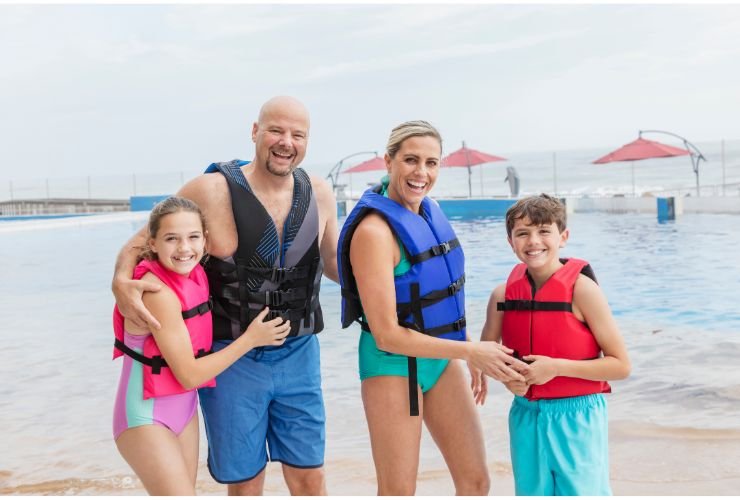
The first and most important thing to look for in a life jacket is the correct fit!
A lifejacket that doesn’t fit you could potentially endanger your life if you need to depend on it to keep you floating.
A proper fit also ensures you feel comfortable throughout your kayaking session.
Many life jackets come with adjustable fittings or can be customized to suit your needs.
The second most important thing is to look for good quality materials.
Most life jackets are made from nylon or PVC – these are a good choice because they resist wear and tear.
A worn out life jacket is worse than useless – it’s potentially dangerous.
The third thing to consider is any extra features you might need.
If you’re kayak fishing in calmer waters, you probably want to opt for comfort and lots of pockets to put equipment in over maximum protection (because that would be overkill).
For more examples of some fantastic life jackets, check out the 20 best PFDs for kayaking in 2023.
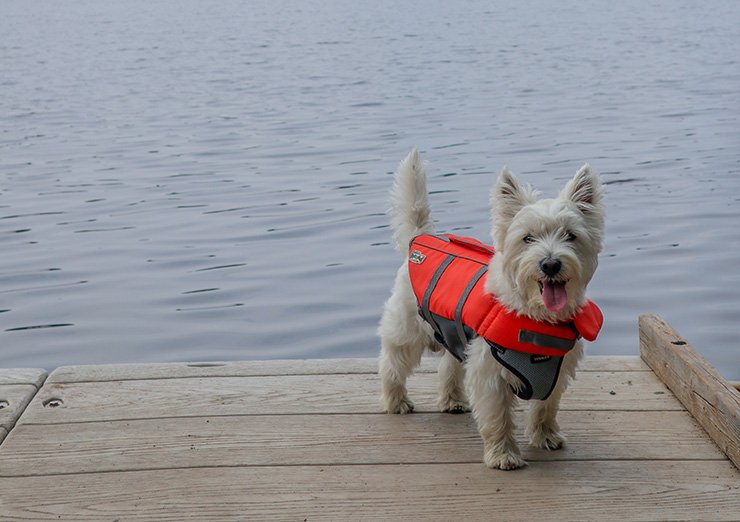
Some Common Life Jacket Misconceptions Among Kayakers
There are some myths or half-truths that need dispelling about life jackets and when you’re supposed to use them.
Life jackets are an incredible invention that have saved thousands of lives. Losing someone because they didn’t take their safety seriously would be a waste of life.
These are some of the most common misconceptions, starting with…
1. A Good Swimmer Doesn’t Need a Life Jacket
It doesn’t matter if you’re Micheal Phelps or any other Olympic swimmer, kayaking can be tiring, especially if you’re on a long expedition.
Kayaking uses the muscles in the shoulders and arms and all of the stabilizer muscles in the upper body. This means if you crash into the water and have to tread water for some time, having a life jacket to aid in your flotation is invaluable.
2. You Don’t Need a Life Jacket if You’re Near the Shore
While local state laws don’t say you always need to wear your life jacket, you should always have one in your vessel. And in many cases, it should be easily accessible.
If you’re found without a life jacket, or the authorities find your life jacket is damaged and ineffective, you can be fined.
Children, even those near the shore, should always wear their life jackets.
3. You Only Need To Wear Your Life Jacket in an Emergency.
This is also incorrect.
It also depends on the type of kayaking you’re doing. For example, if you’re going out from the shore or whitewater kayaking, your life jacket goes on and should stay on.
While you’re not as likely to encounter law enforcement in remote areas, you might not have time to put your life jacket on if you run into trouble.
You should immediately put your life jacket on when you’re paddling in a location where you have even the remotest chance of needing it.
In fact, ninety-nine times out of a hundred, it is simply better to just put on your life jacket and keep it on, rather than mess around and worry about whether you should put it on or not.
The Consequences for Not Wearing a Life Jacket While Kayaking Are Dire

The fact is, accidents are unexpected.
If you’re kayaking in cold waters, for example, your life jacket can give you the assistance you need to get back into your kayak quickly and not risk hypothermia.
If you’re on a prolonged excursion, your life jacket will also support you by keeping you afloat and saving you from drowning because you’re too exhausted to swim.
There’s never a situation where it’s worth not wearing a life jacket. It is the most fundamental piece of safety equipment any kayaker has.
Conclusion – You Do Need To Wear a Life Jacket if You’re Kayaking
Without a doubt, you need a life jacket when you’re kayaking. Not only will it save your life, but it’s also required by law.
Life jackets are a non-negotiable piece of safety equipment that every kayaker uses. They’re not just valuable for emergencies, but they also provide a handy place to store anything that might be useful to have on your person.
Thank you for reading. If you found this article useful then please like, comment, or share.

